Analysis of Aged Care and Disability in Australian Healthcare
VerifiedAdded on 2022/09/21
|10
|2857
|22
Report
AI Summary
This report provides a detailed analysis of the aged care and disability services within the Australian healthcare system. It begins by defining disability and highlighting its prevalence among older adults, emphasizing the need for high-quality healthcare. The report then explores the Australian healthcare system's structure, including funding mechanisms and the Aged Care Act of 1997. It discusses three main types of care: residential care, home care, and flexible care, detailing the services offered under each. The report examines the Commonwealth Support Program and Homecare Package program, including the levels of care provided. Furthermore, it covers residential aged care, flexible care options like transition care, short-term restorative care, multi-purpose services, and innovative care programs. It also addresses specialized programs for specific populations like Indigenous Australians and those with particular needs, such as mental health or those from diverse backgrounds. The report concludes by summarizing the Australian healthcare system's efforts to provide personalized and comprehensive care for the elderly and people with disabilities, highlighting the various government programs and strategies in place.
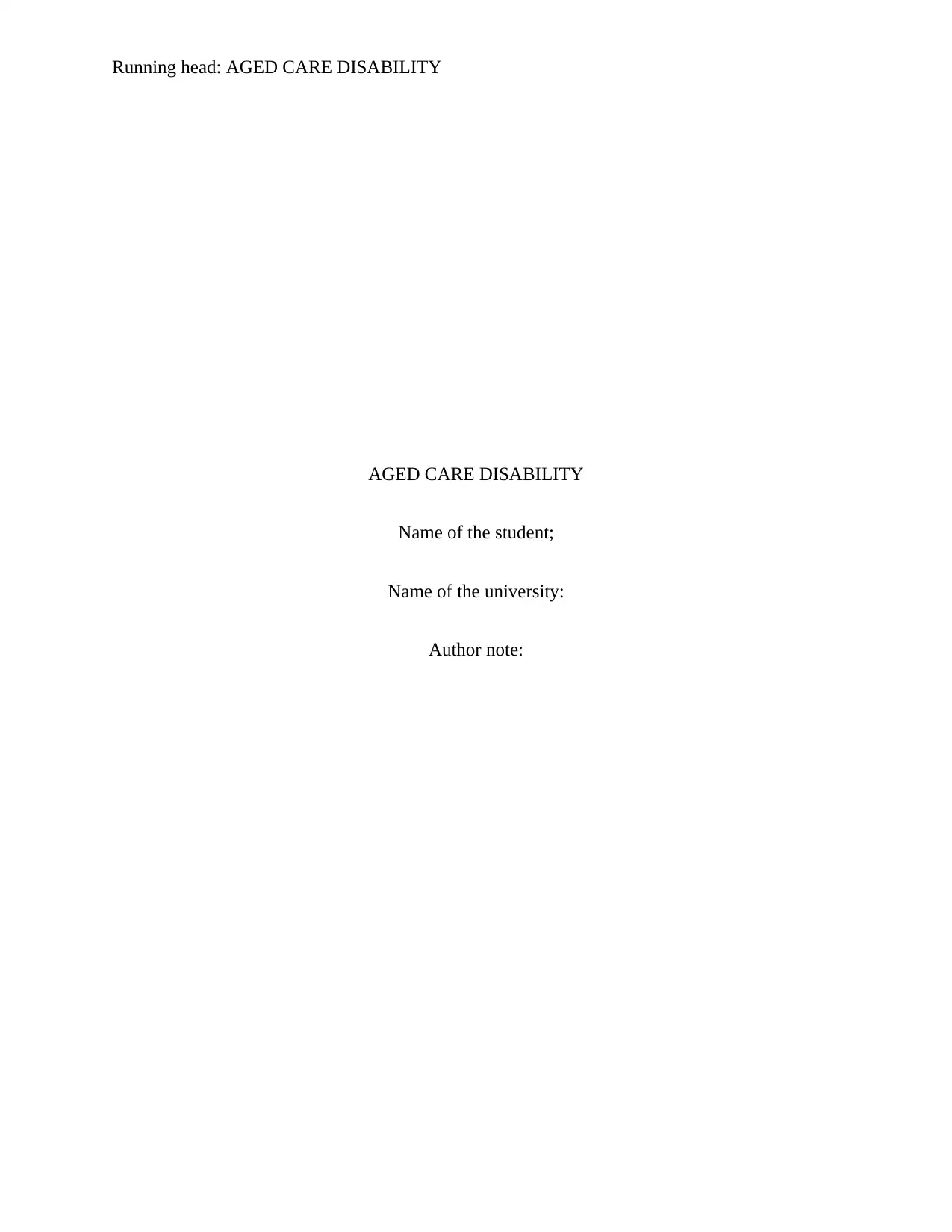
Running head: AGED CARE DISABILITY
AGED CARE DISABILITY
Name of the student;
Name of the university:
Author note:
AGED CARE DISABILITY
Name of the student;
Name of the university:
Author note:
Paraphrase This Document
Need a fresh take? Get an instant paraphrase of this document with our AI Paraphraser
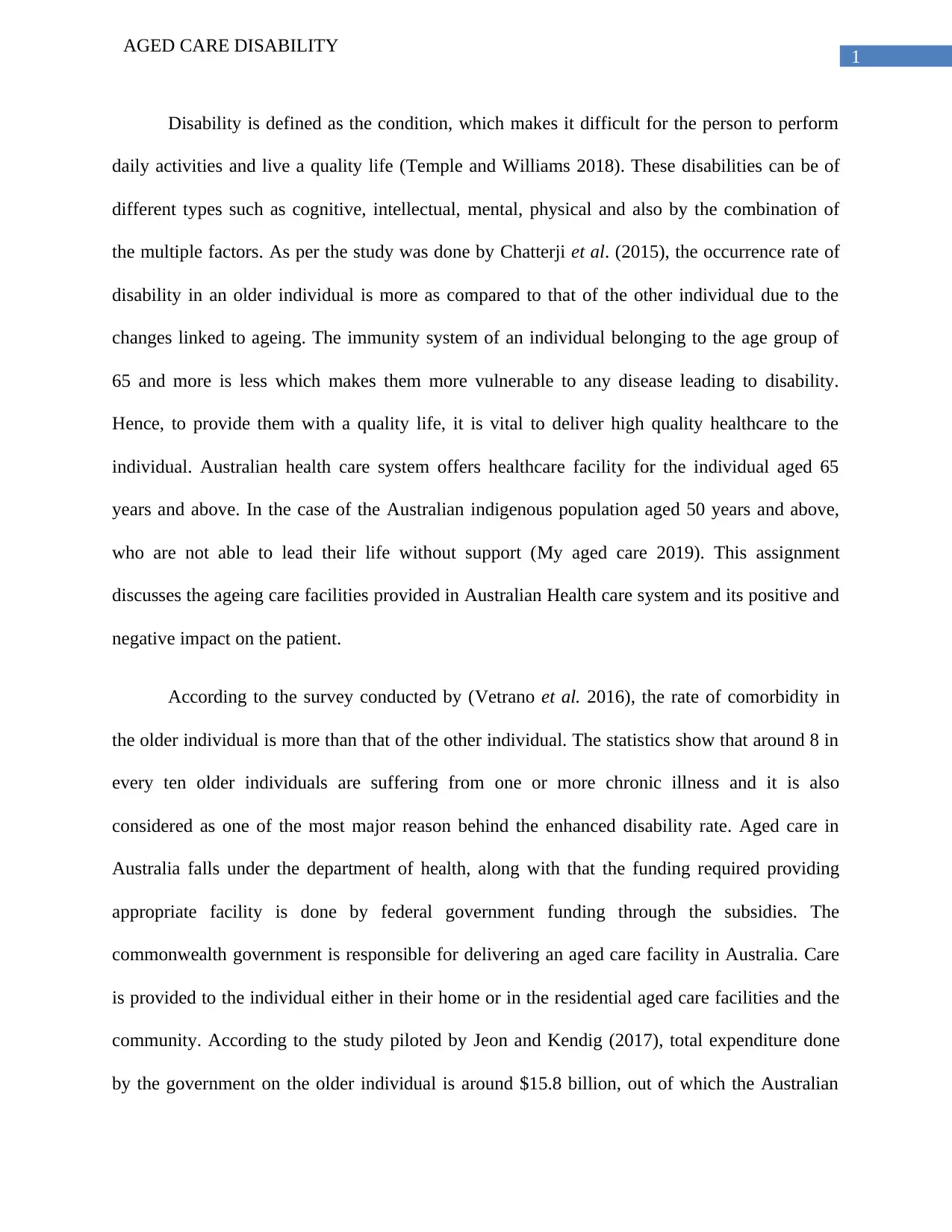
1
AGED CARE DISABILITY
Disability is defined as the condition, which makes it difficult for the person to perform
daily activities and live a quality life (Temple and Williams 2018). These disabilities can be of
different types such as cognitive, intellectual, mental, physical and also by the combination of
the multiple factors. As per the study was done by Chatterji et al. (2015), the occurrence rate of
disability in an older individual is more as compared to that of the other individual due to the
changes linked to ageing. The immunity system of an individual belonging to the age group of
65 and more is less which makes them more vulnerable to any disease leading to disability.
Hence, to provide them with a quality life, it is vital to deliver high quality healthcare to the
individual. Australian health care system offers healthcare facility for the individual aged 65
years and above. In the case of the Australian indigenous population aged 50 years and above,
who are not able to lead their life without support (My aged care 2019). This assignment
discusses the ageing care facilities provided in Australian Health care system and its positive and
negative impact on the patient.
According to the survey conducted by (Vetrano et al. 2016), the rate of comorbidity in
the older individual is more than that of the other individual. The statistics show that around 8 in
every ten older individuals are suffering from one or more chronic illness and it is also
considered as one of the most major reason behind the enhanced disability rate. Aged care in
Australia falls under the department of health, along with that the funding required providing
appropriate facility is done by federal government funding through the subsidies. The
commonwealth government is responsible for delivering an aged care facility in Australia. Care
is provided to the individual either in their home or in the residential aged care facilities and the
community. According to the study piloted by Jeon and Kendig (2017), total expenditure done
by the government on the older individual is around $15.8 billion, out of which the Australian
AGED CARE DISABILITY
Disability is defined as the condition, which makes it difficult for the person to perform
daily activities and live a quality life (Temple and Williams 2018). These disabilities can be of
different types such as cognitive, intellectual, mental, physical and also by the combination of
the multiple factors. As per the study was done by Chatterji et al. (2015), the occurrence rate of
disability in an older individual is more as compared to that of the other individual due to the
changes linked to ageing. The immunity system of an individual belonging to the age group of
65 and more is less which makes them more vulnerable to any disease leading to disability.
Hence, to provide them with a quality life, it is vital to deliver high quality healthcare to the
individual. Australian health care system offers healthcare facility for the individual aged 65
years and above. In the case of the Australian indigenous population aged 50 years and above,
who are not able to lead their life without support (My aged care 2019). This assignment
discusses the ageing care facilities provided in Australian Health care system and its positive and
negative impact on the patient.
According to the survey conducted by (Vetrano et al. 2016), the rate of comorbidity in
the older individual is more than that of the other individual. The statistics show that around 8 in
every ten older individuals are suffering from one or more chronic illness and it is also
considered as one of the most major reason behind the enhanced disability rate. Aged care in
Australia falls under the department of health, along with that the funding required providing
appropriate facility is done by federal government funding through the subsidies. The
commonwealth government is responsible for delivering an aged care facility in Australia. Care
is provided to the individual either in their home or in the residential aged care facilities and the
community. According to the study piloted by Jeon and Kendig (2017), total expenditure done
by the government on the older individual is around $15.8 billion, out of which the Australian
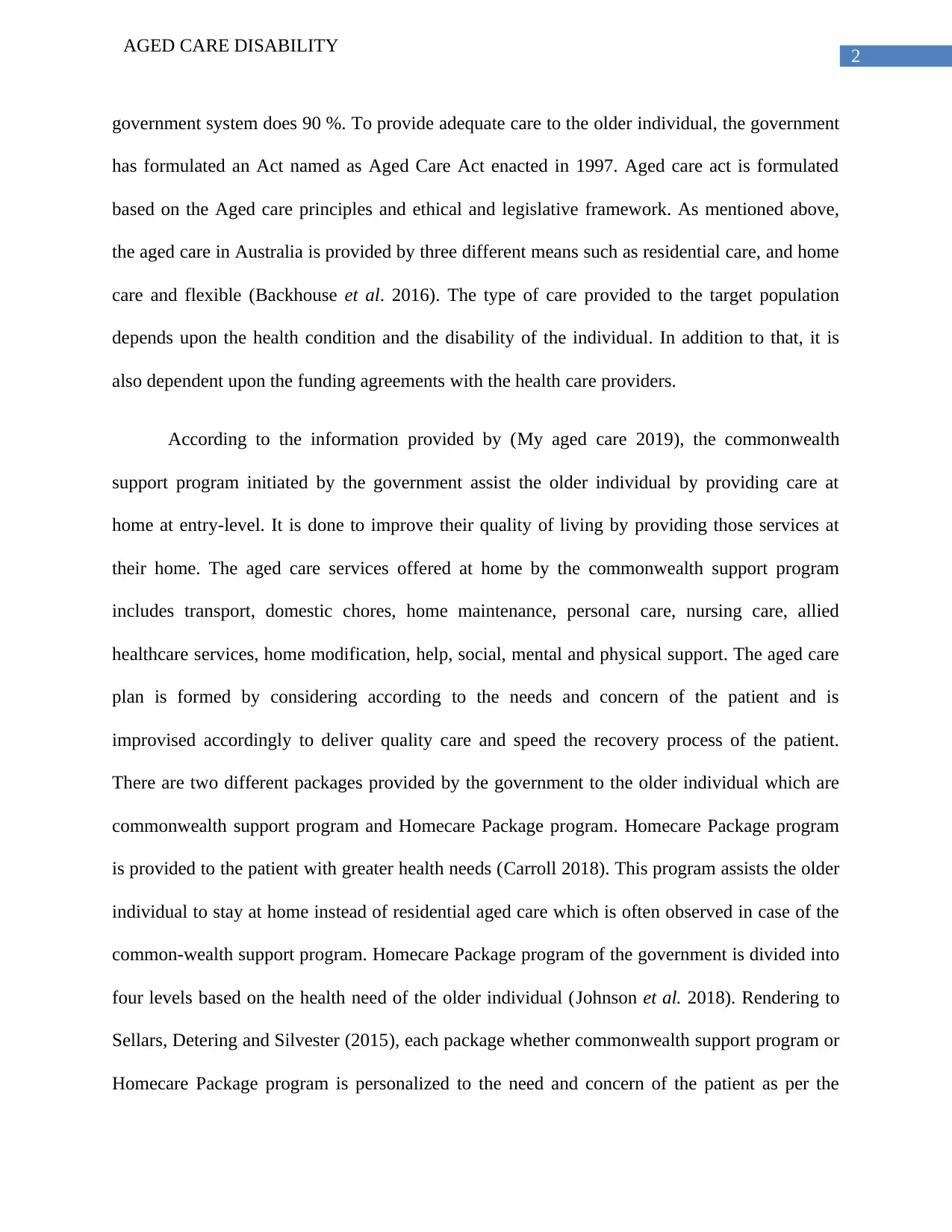
2
AGED CARE DISABILITY
government system does 90 %. To provide adequate care to the older individual, the government
has formulated an Act named as Aged Care Act enacted in 1997. Aged care act is formulated
based on the Aged care principles and ethical and legislative framework. As mentioned above,
the aged care in Australia is provided by three different means such as residential care, and home
care and flexible (Backhouse et al. 2016). The type of care provided to the target population
depends upon the health condition and the disability of the individual. In addition to that, it is
also dependent upon the funding agreements with the health care providers.
According to the information provided by (My aged care 2019), the commonwealth
support program initiated by the government assist the older individual by providing care at
home at entry-level. It is done to improve their quality of living by providing those services at
their home. The aged care services offered at home by the commonwealth support program
includes transport, domestic chores, home maintenance, personal care, nursing care, allied
healthcare services, home modification, help, social, mental and physical support. The aged care
plan is formed by considering according to the needs and concern of the patient and is
improvised accordingly to deliver quality care and speed the recovery process of the patient.
There are two different packages provided by the government to the older individual which are
commonwealth support program and Homecare Package program. Homecare Package program
is provided to the patient with greater health needs (Carroll 2018). This program assists the older
individual to stay at home instead of residential aged care which is often observed in case of the
common-wealth support program. Homecare Package program of the government is divided into
four levels based on the health need of the older individual (Johnson et al. 2018). Rendering to
Sellars, Detering and Silvester (2015), each package whether commonwealth support program or
Homecare Package program is personalized to the need and concern of the patient as per the
AGED CARE DISABILITY
government system does 90 %. To provide adequate care to the older individual, the government
has formulated an Act named as Aged Care Act enacted in 1997. Aged care act is formulated
based on the Aged care principles and ethical and legislative framework. As mentioned above,
the aged care in Australia is provided by three different means such as residential care, and home
care and flexible (Backhouse et al. 2016). The type of care provided to the target population
depends upon the health condition and the disability of the individual. In addition to that, it is
also dependent upon the funding agreements with the health care providers.
According to the information provided by (My aged care 2019), the commonwealth
support program initiated by the government assist the older individual by providing care at
home at entry-level. It is done to improve their quality of living by providing those services at
their home. The aged care services offered at home by the commonwealth support program
includes transport, domestic chores, home maintenance, personal care, nursing care, allied
healthcare services, home modification, help, social, mental and physical support. The aged care
plan is formed by considering according to the needs and concern of the patient and is
improvised accordingly to deliver quality care and speed the recovery process of the patient.
There are two different packages provided by the government to the older individual which are
commonwealth support program and Homecare Package program. Homecare Package program
is provided to the patient with greater health needs (Carroll 2018). This program assists the older
individual to stay at home instead of residential aged care which is often observed in case of the
common-wealth support program. Homecare Package program of the government is divided into
four levels based on the health need of the older individual (Johnson et al. 2018). Rendering to
Sellars, Detering and Silvester (2015), each package whether commonwealth support program or
Homecare Package program is personalized to the need and concern of the patient as per the
⊘ This is a preview!⊘
Do you want full access?
Subscribe today to unlock all pages.

Trusted by 1+ million students worldwide
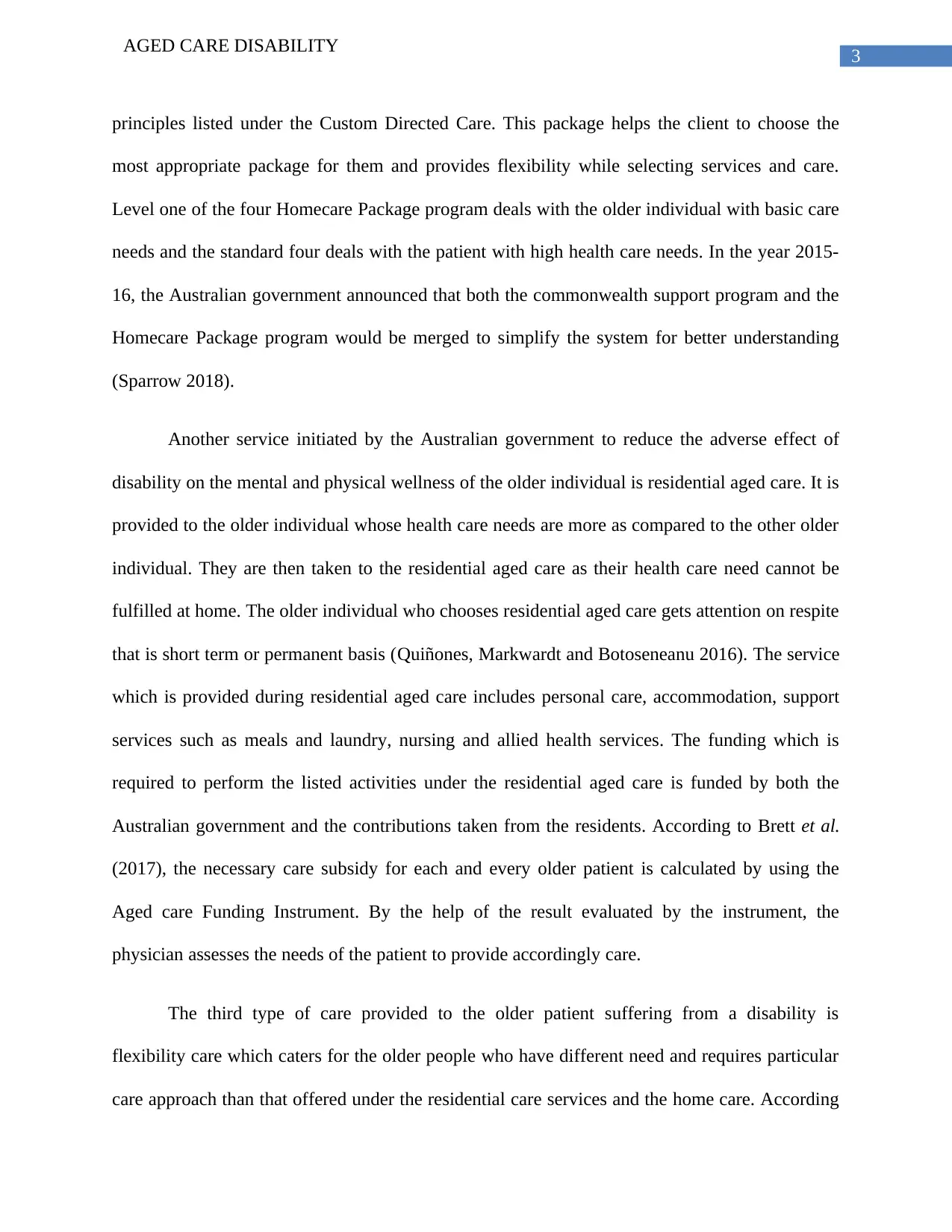
3
AGED CARE DISABILITY
principles listed under the Custom Directed Care. This package helps the client to choose the
most appropriate package for them and provides flexibility while selecting services and care.
Level one of the four Homecare Package program deals with the older individual with basic care
needs and the standard four deals with the patient with high health care needs. In the year 2015-
16, the Australian government announced that both the commonwealth support program and the
Homecare Package program would be merged to simplify the system for better understanding
(Sparrow 2018).
Another service initiated by the Australian government to reduce the adverse effect of
disability on the mental and physical wellness of the older individual is residential aged care. It is
provided to the older individual whose health care needs are more as compared to the other older
individual. They are then taken to the residential aged care as their health care need cannot be
fulfilled at home. The older individual who chooses residential aged care gets attention on respite
that is short term or permanent basis (Quiñones, Markwardt and Botoseneanu 2016). The service
which is provided during residential aged care includes personal care, accommodation, support
services such as meals and laundry, nursing and allied health services. The funding which is
required to perform the listed activities under the residential aged care is funded by both the
Australian government and the contributions taken from the residents. According to Brett et al.
(2017), the necessary care subsidy for each and every older patient is calculated by using the
Aged care Funding Instrument. By the help of the result evaluated by the instrument, the
physician assesses the needs of the patient to provide accordingly care.
The third type of care provided to the older patient suffering from a disability is
flexibility care which caters for the older people who have different need and requires particular
care approach than that offered under the residential care services and the home care. According
AGED CARE DISABILITY
principles listed under the Custom Directed Care. This package helps the client to choose the
most appropriate package for them and provides flexibility while selecting services and care.
Level one of the four Homecare Package program deals with the older individual with basic care
needs and the standard four deals with the patient with high health care needs. In the year 2015-
16, the Australian government announced that both the commonwealth support program and the
Homecare Package program would be merged to simplify the system for better understanding
(Sparrow 2018).
Another service initiated by the Australian government to reduce the adverse effect of
disability on the mental and physical wellness of the older individual is residential aged care. It is
provided to the older individual whose health care needs are more as compared to the other older
individual. They are then taken to the residential aged care as their health care need cannot be
fulfilled at home. The older individual who chooses residential aged care gets attention on respite
that is short term or permanent basis (Quiñones, Markwardt and Botoseneanu 2016). The service
which is provided during residential aged care includes personal care, accommodation, support
services such as meals and laundry, nursing and allied health services. The funding which is
required to perform the listed activities under the residential aged care is funded by both the
Australian government and the contributions taken from the residents. According to Brett et al.
(2017), the necessary care subsidy for each and every older patient is calculated by using the
Aged care Funding Instrument. By the help of the result evaluated by the instrument, the
physician assesses the needs of the patient to provide accordingly care.
The third type of care provided to the older patient suffering from a disability is
flexibility care which caters for the older people who have different need and requires particular
care approach than that offered under the residential care services and the home care. According
Paraphrase This Document
Need a fresh take? Get an instant paraphrase of this document with our AI Paraphraser
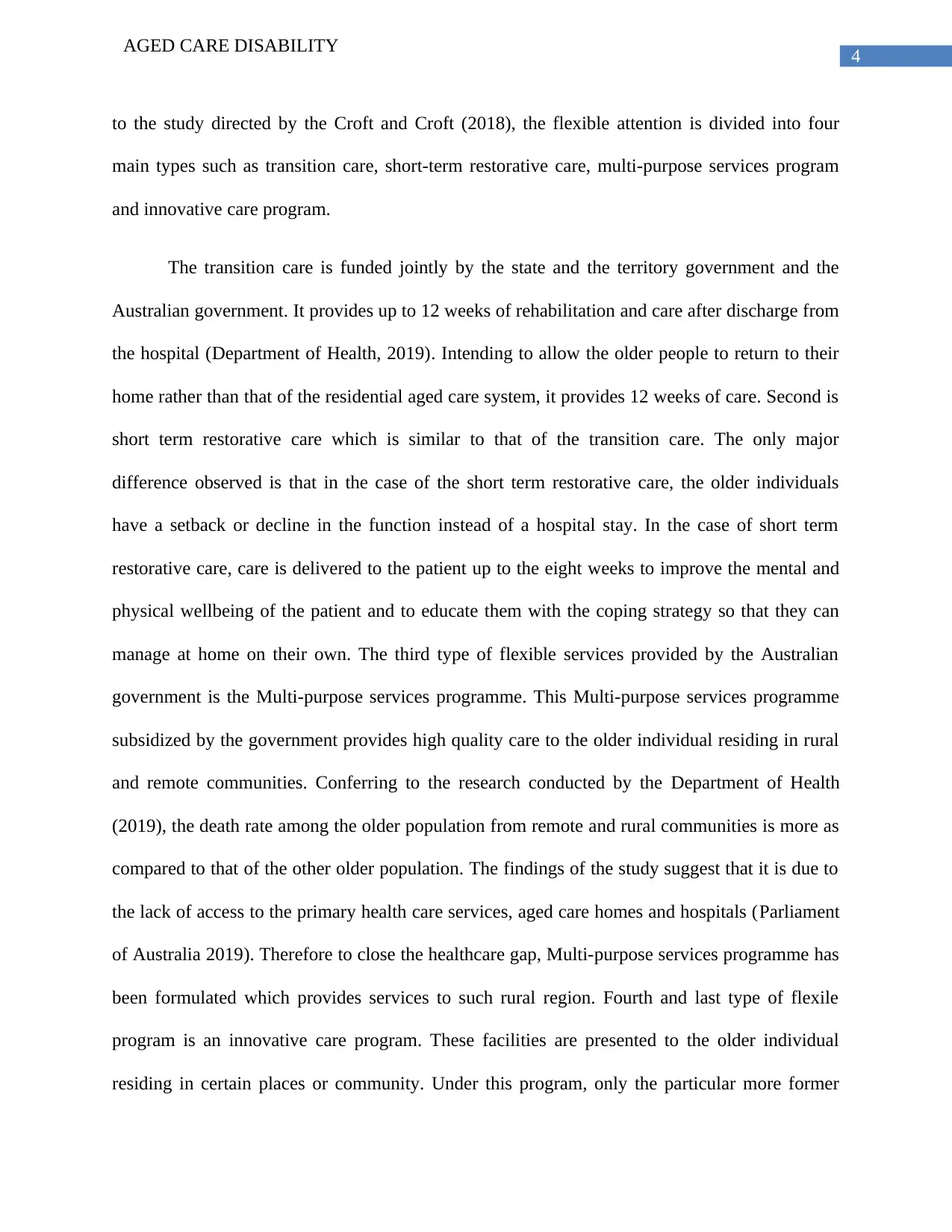
4
AGED CARE DISABILITY
to the study directed by the Croft and Croft (2018), the flexible attention is divided into four
main types such as transition care, short-term restorative care, multi-purpose services program
and innovative care program.
The transition care is funded jointly by the state and the territory government and the
Australian government. It provides up to 12 weeks of rehabilitation and care after discharge from
the hospital (Department of Health, 2019). Intending to allow the older people to return to their
home rather than that of the residential aged care system, it provides 12 weeks of care. Second is
short term restorative care which is similar to that of the transition care. The only major
difference observed is that in the case of the short term restorative care, the older individuals
have a setback or decline in the function instead of a hospital stay. In the case of short term
restorative care, care is delivered to the patient up to the eight weeks to improve the mental and
physical wellbeing of the patient and to educate them with the coping strategy so that they can
manage at home on their own. The third type of flexible services provided by the Australian
government is the Multi-purpose services programme. This Multi-purpose services programme
subsidized by the government provides high quality care to the older individual residing in rural
and remote communities. Conferring to the research conducted by the Department of Health
(2019), the death rate among the older population from remote and rural communities is more as
compared to that of the other older population. The findings of the study suggest that it is due to
the lack of access to the primary health care services, aged care homes and hospitals (Parliament
of Australia 2019). Therefore to close the healthcare gap, Multi-purpose services programme has
been formulated which provides services to such rural region. Fourth and last type of flexile
program is an innovative care program. These facilities are presented to the older individual
residing in certain places or community. Under this program, only the particular more former
AGED CARE DISABILITY
to the study directed by the Croft and Croft (2018), the flexible attention is divided into four
main types such as transition care, short-term restorative care, multi-purpose services program
and innovative care program.
The transition care is funded jointly by the state and the territory government and the
Australian government. It provides up to 12 weeks of rehabilitation and care after discharge from
the hospital (Department of Health, 2019). Intending to allow the older people to return to their
home rather than that of the residential aged care system, it provides 12 weeks of care. Second is
short term restorative care which is similar to that of the transition care. The only major
difference observed is that in the case of the short term restorative care, the older individuals
have a setback or decline in the function instead of a hospital stay. In the case of short term
restorative care, care is delivered to the patient up to the eight weeks to improve the mental and
physical wellbeing of the patient and to educate them with the coping strategy so that they can
manage at home on their own. The third type of flexible services provided by the Australian
government is the Multi-purpose services programme. This Multi-purpose services programme
subsidized by the government provides high quality care to the older individual residing in rural
and remote communities. Conferring to the research conducted by the Department of Health
(2019), the death rate among the older population from remote and rural communities is more as
compared to that of the other older population. The findings of the study suggest that it is due to
the lack of access to the primary health care services, aged care homes and hospitals (Parliament
of Australia 2019). Therefore to close the healthcare gap, Multi-purpose services programme has
been formulated which provides services to such rural region. Fourth and last type of flexile
program is an innovative care program. These facilities are presented to the older individual
residing in certain places or community. Under this program, only the particular more former
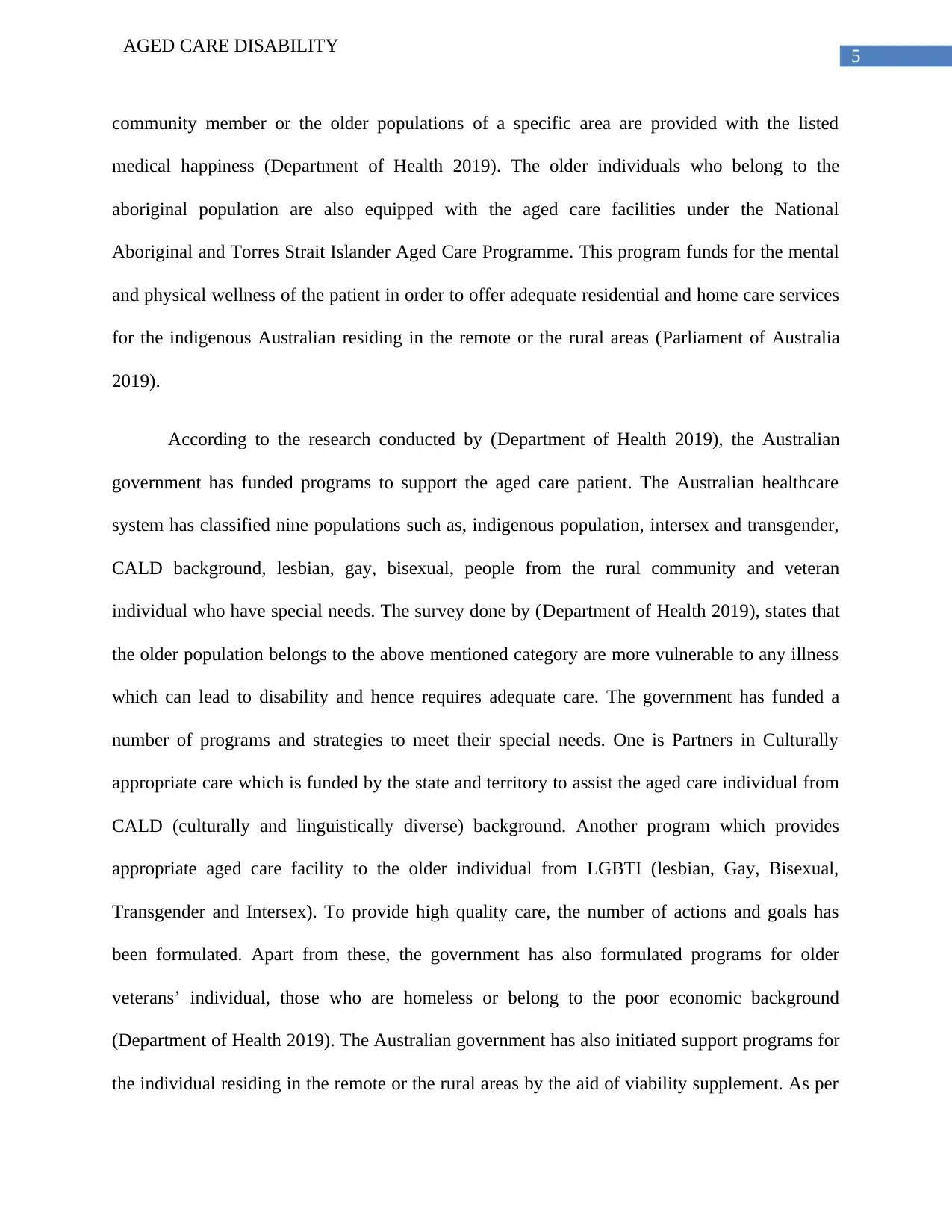
5
AGED CARE DISABILITY
community member or the older populations of a specific area are provided with the listed
medical happiness (Department of Health 2019). The older individuals who belong to the
aboriginal population are also equipped with the aged care facilities under the National
Aboriginal and Torres Strait Islander Aged Care Programme. This program funds for the mental
and physical wellness of the patient in order to offer adequate residential and home care services
for the indigenous Australian residing in the remote or the rural areas (Parliament of Australia
2019).
According to the research conducted by (Department of Health 2019), the Australian
government has funded programs to support the aged care patient. The Australian healthcare
system has classified nine populations such as, indigenous population, intersex and transgender,
CALD background, lesbian, gay, bisexual, people from the rural community and veteran
individual who have special needs. The survey done by (Department of Health 2019), states that
the older population belongs to the above mentioned category are more vulnerable to any illness
which can lead to disability and hence requires adequate care. The government has funded a
number of programs and strategies to meet their special needs. One is Partners in Culturally
appropriate care which is funded by the state and territory to assist the aged care individual from
CALD (culturally and linguistically diverse) background. Another program which provides
appropriate aged care facility to the older individual from LGBTI (lesbian, Gay, Bisexual,
Transgender and Intersex). To provide high quality care, the number of actions and goals has
been formulated. Apart from these, the government has also formulated programs for older
veterans’ individual, those who are homeless or belong to the poor economic background
(Department of Health 2019). The Australian government has also initiated support programs for
the individual residing in the remote or the rural areas by the aid of viability supplement. As per
AGED CARE DISABILITY
community member or the older populations of a specific area are provided with the listed
medical happiness (Department of Health 2019). The older individuals who belong to the
aboriginal population are also equipped with the aged care facilities under the National
Aboriginal and Torres Strait Islander Aged Care Programme. This program funds for the mental
and physical wellness of the patient in order to offer adequate residential and home care services
for the indigenous Australian residing in the remote or the rural areas (Parliament of Australia
2019).
According to the research conducted by (Department of Health 2019), the Australian
government has funded programs to support the aged care patient. The Australian healthcare
system has classified nine populations such as, indigenous population, intersex and transgender,
CALD background, lesbian, gay, bisexual, people from the rural community and veteran
individual who have special needs. The survey done by (Department of Health 2019), states that
the older population belongs to the above mentioned category are more vulnerable to any illness
which can lead to disability and hence requires adequate care. The government has funded a
number of programs and strategies to meet their special needs. One is Partners in Culturally
appropriate care which is funded by the state and territory to assist the aged care individual from
CALD (culturally and linguistically diverse) background. Another program which provides
appropriate aged care facility to the older individual from LGBTI (lesbian, Gay, Bisexual,
Transgender and Intersex). To provide high quality care, the number of actions and goals has
been formulated. Apart from these, the government has also formulated programs for older
veterans’ individual, those who are homeless or belong to the poor economic background
(Department of Health 2019). The Australian government has also initiated support programs for
the individual residing in the remote or the rural areas by the aid of viability supplement. As per
⊘ This is a preview!⊘
Do you want full access?
Subscribe today to unlock all pages.

Trusted by 1+ million students worldwide
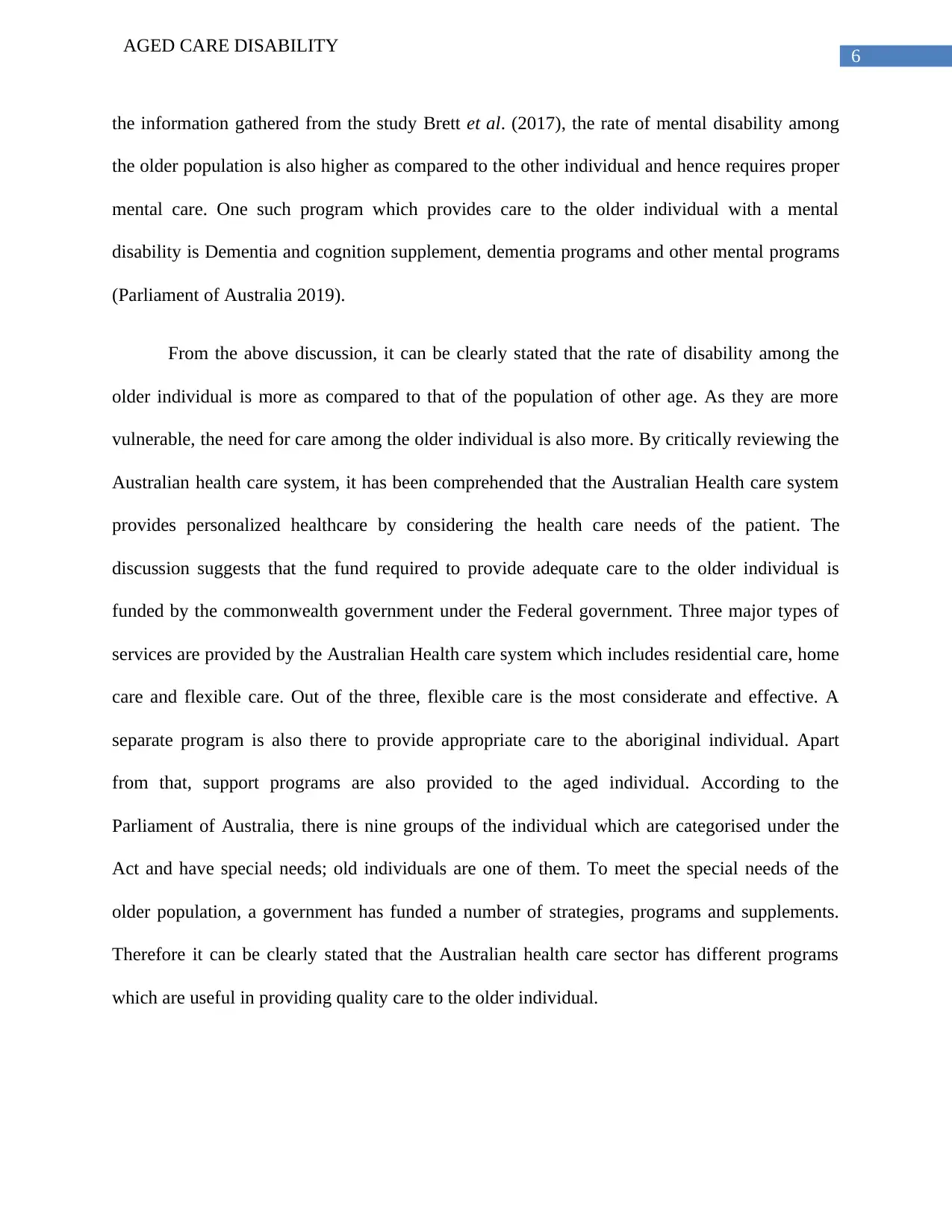
6
AGED CARE DISABILITY
the information gathered from the study Brett et al. (2017), the rate of mental disability among
the older population is also higher as compared to the other individual and hence requires proper
mental care. One such program which provides care to the older individual with a mental
disability is Dementia and cognition supplement, dementia programs and other mental programs
(Parliament of Australia 2019).
From the above discussion, it can be clearly stated that the rate of disability among the
older individual is more as compared to that of the population of other age. As they are more
vulnerable, the need for care among the older individual is also more. By critically reviewing the
Australian health care system, it has been comprehended that the Australian Health care system
provides personalized healthcare by considering the health care needs of the patient. The
discussion suggests that the fund required to provide adequate care to the older individual is
funded by the commonwealth government under the Federal government. Three major types of
services are provided by the Australian Health care system which includes residential care, home
care and flexible care. Out of the three, flexible care is the most considerate and effective. A
separate program is also there to provide appropriate care to the aboriginal individual. Apart
from that, support programs are also provided to the aged individual. According to the
Parliament of Australia, there is nine groups of the individual which are categorised under the
Act and have special needs; old individuals are one of them. To meet the special needs of the
older population, a government has funded a number of strategies, programs and supplements.
Therefore it can be clearly stated that the Australian health care sector has different programs
which are useful in providing quality care to the older individual.
AGED CARE DISABILITY
the information gathered from the study Brett et al. (2017), the rate of mental disability among
the older population is also higher as compared to the other individual and hence requires proper
mental care. One such program which provides care to the older individual with a mental
disability is Dementia and cognition supplement, dementia programs and other mental programs
(Parliament of Australia 2019).
From the above discussion, it can be clearly stated that the rate of disability among the
older individual is more as compared to that of the population of other age. As they are more
vulnerable, the need for care among the older individual is also more. By critically reviewing the
Australian health care system, it has been comprehended that the Australian Health care system
provides personalized healthcare by considering the health care needs of the patient. The
discussion suggests that the fund required to provide adequate care to the older individual is
funded by the commonwealth government under the Federal government. Three major types of
services are provided by the Australian Health care system which includes residential care, home
care and flexible care. Out of the three, flexible care is the most considerate and effective. A
separate program is also there to provide appropriate care to the aboriginal individual. Apart
from that, support programs are also provided to the aged individual. According to the
Parliament of Australia, there is nine groups of the individual which are categorised under the
Act and have special needs; old individuals are one of them. To meet the special needs of the
older population, a government has funded a number of strategies, programs and supplements.
Therefore it can be clearly stated that the Australian health care sector has different programs
which are useful in providing quality care to the older individual.
Paraphrase This Document
Need a fresh take? Get an instant paraphrase of this document with our AI Paraphraser
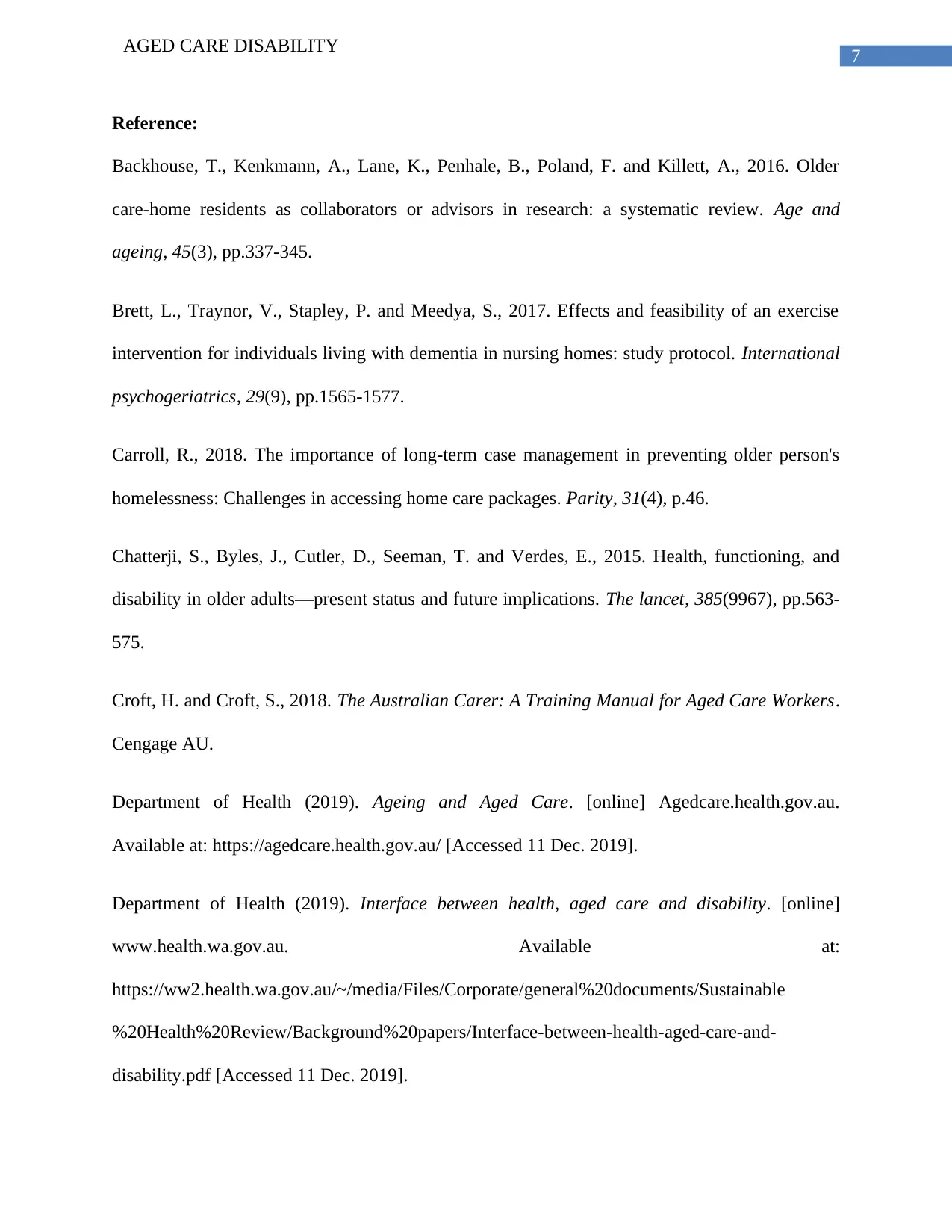
7
AGED CARE DISABILITY
Reference:
Backhouse, T., Kenkmann, A., Lane, K., Penhale, B., Poland, F. and Killett, A., 2016. Older
care-home residents as collaborators or advisors in research: a systematic review. Age and
ageing, 45(3), pp.337-345.
Brett, L., Traynor, V., Stapley, P. and Meedya, S., 2017. Effects and feasibility of an exercise
intervention for individuals living with dementia in nursing homes: study protocol. International
psychogeriatrics, 29(9), pp.1565-1577.
Carroll, R., 2018. The importance of long-term case management in preventing older person's
homelessness: Challenges in accessing home care packages. Parity, 31(4), p.46.
Chatterji, S., Byles, J., Cutler, D., Seeman, T. and Verdes, E., 2015. Health, functioning, and
disability in older adults—present status and future implications. The lancet, 385(9967), pp.563-
575.
Croft, H. and Croft, S., 2018. The Australian Carer: A Training Manual for Aged Care Workers.
Cengage AU.
Department of Health (2019). Ageing and Aged Care. [online] Agedcare.health.gov.au.
Available at: https://agedcare.health.gov.au/ [Accessed 11 Dec. 2019].
Department of Health (2019). Interface between health, aged care and disability. [online]
www.health.wa.gov.au. Available at:
https://ww2.health.wa.gov.au/~/media/Files/Corporate/general%20documents/Sustainable
%20Health%20Review/Background%20papers/Interface-between-health-aged-care-and-
disability.pdf [Accessed 11 Dec. 2019].
AGED CARE DISABILITY
Reference:
Backhouse, T., Kenkmann, A., Lane, K., Penhale, B., Poland, F. and Killett, A., 2016. Older
care-home residents as collaborators or advisors in research: a systematic review. Age and
ageing, 45(3), pp.337-345.
Brett, L., Traynor, V., Stapley, P. and Meedya, S., 2017. Effects and feasibility of an exercise
intervention for individuals living with dementia in nursing homes: study protocol. International
psychogeriatrics, 29(9), pp.1565-1577.
Carroll, R., 2018. The importance of long-term case management in preventing older person's
homelessness: Challenges in accessing home care packages. Parity, 31(4), p.46.
Chatterji, S., Byles, J., Cutler, D., Seeman, T. and Verdes, E., 2015. Health, functioning, and
disability in older adults—present status and future implications. The lancet, 385(9967), pp.563-
575.
Croft, H. and Croft, S., 2018. The Australian Carer: A Training Manual for Aged Care Workers.
Cengage AU.
Department of Health (2019). Ageing and Aged Care. [online] Agedcare.health.gov.au.
Available at: https://agedcare.health.gov.au/ [Accessed 11 Dec. 2019].
Department of Health (2019). Interface between health, aged care and disability. [online]
www.health.wa.gov.au. Available at:
https://ww2.health.wa.gov.au/~/media/Files/Corporate/general%20documents/Sustainable
%20Health%20Review/Background%20papers/Interface-between-health-aged-care-and-
disability.pdf [Accessed 11 Dec. 2019].
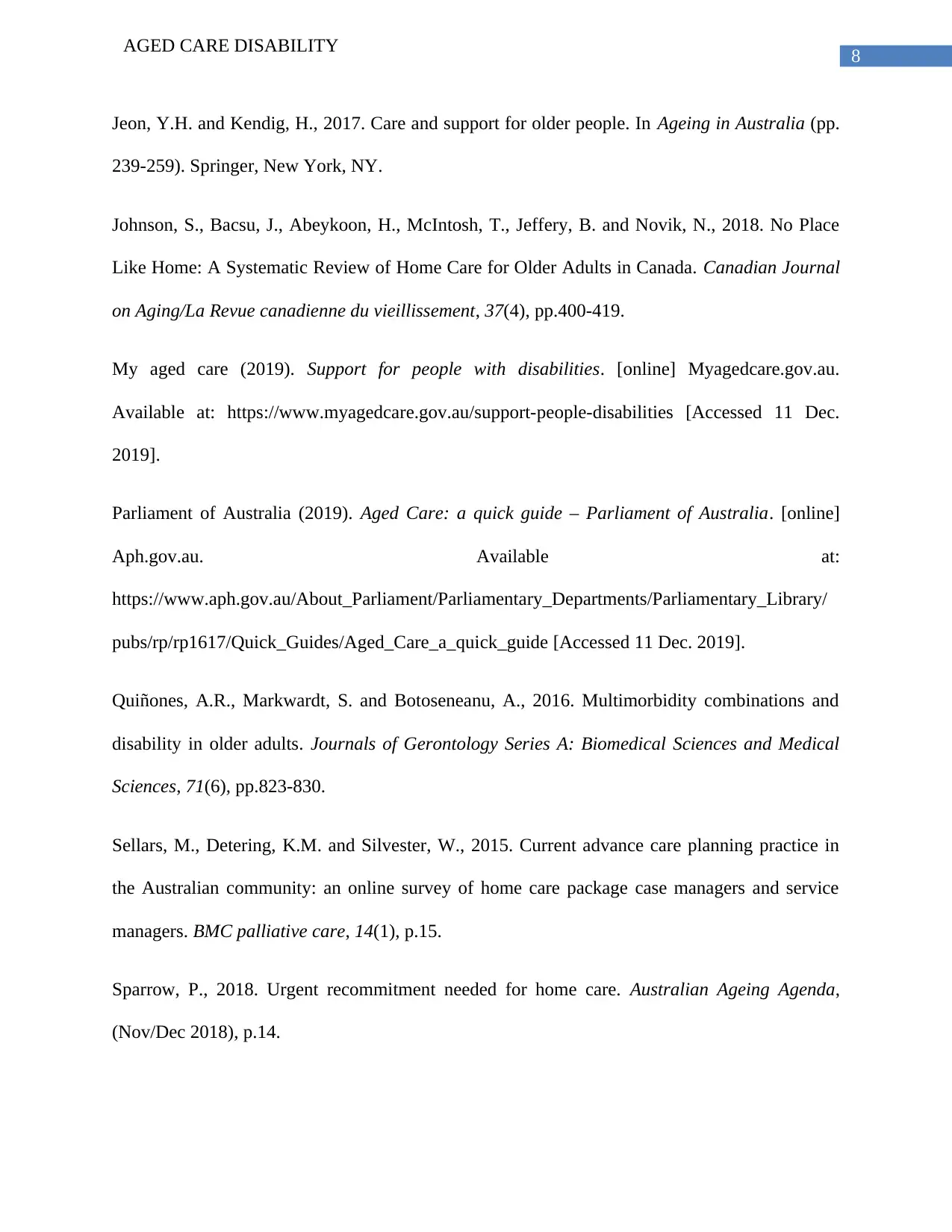
8
AGED CARE DISABILITY
Jeon, Y.H. and Kendig, H., 2017. Care and support for older people. In Ageing in Australia (pp.
239-259). Springer, New York, NY.
Johnson, S., Bacsu, J., Abeykoon, H., McIntosh, T., Jeffery, B. and Novik, N., 2018. No Place
Like Home: A Systematic Review of Home Care for Older Adults in Canada. Canadian Journal
on Aging/La Revue canadienne du vieillissement, 37(4), pp.400-419.
My aged care (2019). Support for people with disabilities. [online] Myagedcare.gov.au.
Available at: https://www.myagedcare.gov.au/support-people-disabilities [Accessed 11 Dec.
2019].
Parliament of Australia (2019). Aged Care: a quick guide – Parliament of Australia. [online]
Aph.gov.au. Available at:
https://www.aph.gov.au/About_Parliament/Parliamentary_Departments/Parliamentary_Library/
pubs/rp/rp1617/Quick_Guides/Aged_Care_a_quick_guide [Accessed 11 Dec. 2019].
Quiñones, A.R., Markwardt, S. and Botoseneanu, A., 2016. Multimorbidity combinations and
disability in older adults. Journals of Gerontology Series A: Biomedical Sciences and Medical
Sciences, 71(6), pp.823-830.
Sellars, M., Detering, K.M. and Silvester, W., 2015. Current advance care planning practice in
the Australian community: an online survey of home care package case managers and service
managers. BMC palliative care, 14(1), p.15.
Sparrow, P., 2018. Urgent recommitment needed for home care. Australian Ageing Agenda,
(Nov/Dec 2018), p.14.
AGED CARE DISABILITY
Jeon, Y.H. and Kendig, H., 2017. Care and support for older people. In Ageing in Australia (pp.
239-259). Springer, New York, NY.
Johnson, S., Bacsu, J., Abeykoon, H., McIntosh, T., Jeffery, B. and Novik, N., 2018. No Place
Like Home: A Systematic Review of Home Care for Older Adults in Canada. Canadian Journal
on Aging/La Revue canadienne du vieillissement, 37(4), pp.400-419.
My aged care (2019). Support for people with disabilities. [online] Myagedcare.gov.au.
Available at: https://www.myagedcare.gov.au/support-people-disabilities [Accessed 11 Dec.
2019].
Parliament of Australia (2019). Aged Care: a quick guide – Parliament of Australia. [online]
Aph.gov.au. Available at:
https://www.aph.gov.au/About_Parliament/Parliamentary_Departments/Parliamentary_Library/
pubs/rp/rp1617/Quick_Guides/Aged_Care_a_quick_guide [Accessed 11 Dec. 2019].
Quiñones, A.R., Markwardt, S. and Botoseneanu, A., 2016. Multimorbidity combinations and
disability in older adults. Journals of Gerontology Series A: Biomedical Sciences and Medical
Sciences, 71(6), pp.823-830.
Sellars, M., Detering, K.M. and Silvester, W., 2015. Current advance care planning practice in
the Australian community: an online survey of home care package case managers and service
managers. BMC palliative care, 14(1), p.15.
Sparrow, P., 2018. Urgent recommitment needed for home care. Australian Ageing Agenda,
(Nov/Dec 2018), p.14.
⊘ This is a preview!⊘
Do you want full access?
Subscribe today to unlock all pages.

Trusted by 1+ million students worldwide
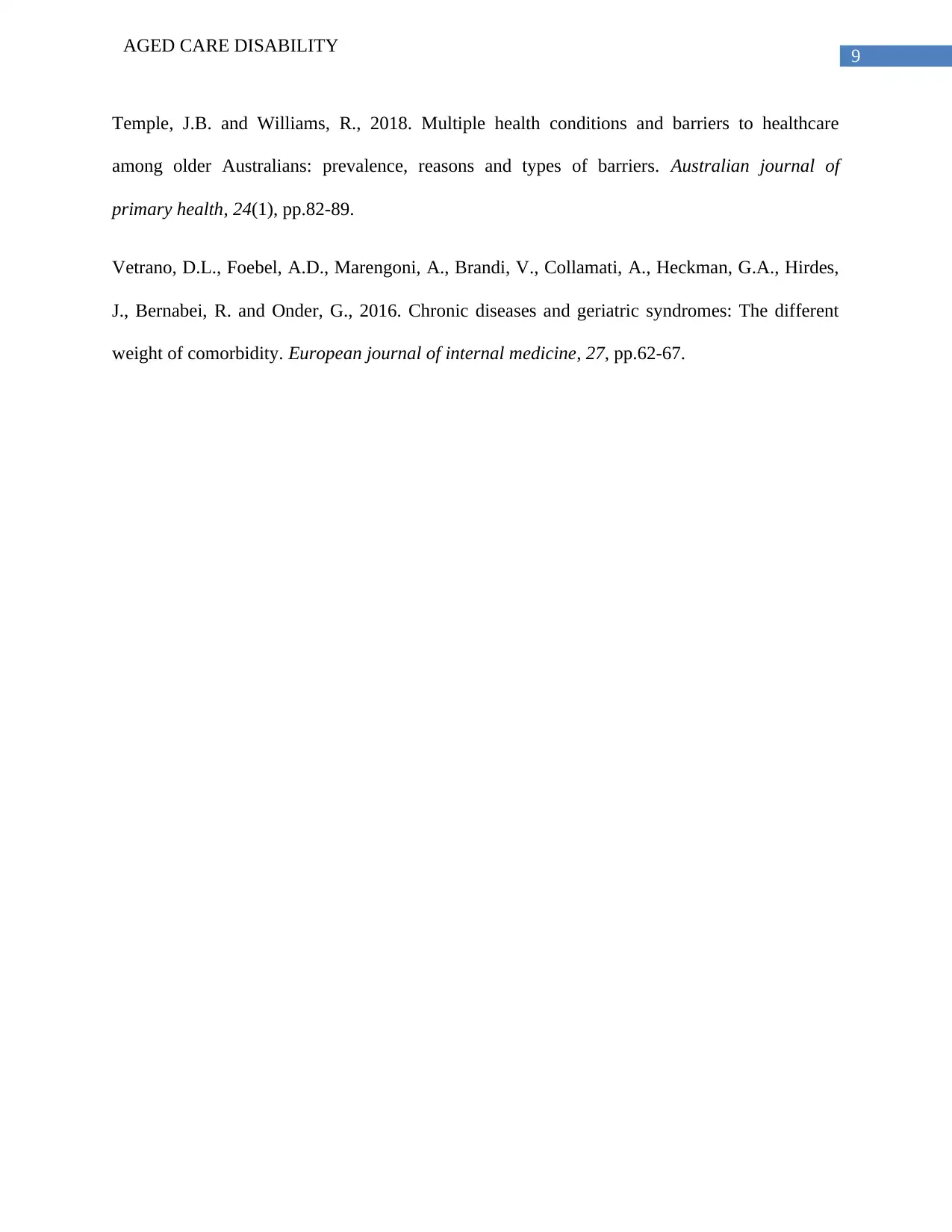
9
AGED CARE DISABILITY
Temple, J.B. and Williams, R., 2018. Multiple health conditions and barriers to healthcare
among older Australians: prevalence, reasons and types of barriers. Australian journal of
primary health, 24(1), pp.82-89.
Vetrano, D.L., Foebel, A.D., Marengoni, A., Brandi, V., Collamati, A., Heckman, G.A., Hirdes,
J., Bernabei, R. and Onder, G., 2016. Chronic diseases and geriatric syndromes: The different
weight of comorbidity. European journal of internal medicine, 27, pp.62-67.
AGED CARE DISABILITY
Temple, J.B. and Williams, R., 2018. Multiple health conditions and barriers to healthcare
among older Australians: prevalence, reasons and types of barriers. Australian journal of
primary health, 24(1), pp.82-89.
Vetrano, D.L., Foebel, A.D., Marengoni, A., Brandi, V., Collamati, A., Heckman, G.A., Hirdes,
J., Bernabei, R. and Onder, G., 2016. Chronic diseases and geriatric syndromes: The different
weight of comorbidity. European journal of internal medicine, 27, pp.62-67.
1 out of 10
Related Documents
Your All-in-One AI-Powered Toolkit for Academic Success.
+13062052269
info@desklib.com
Available 24*7 on WhatsApp / Email
![[object Object]](/_next/static/media/star-bottom.7253800d.svg)
Unlock your academic potential
Copyright © 2020–2025 A2Z Services. All Rights Reserved. Developed and managed by ZUCOL.





